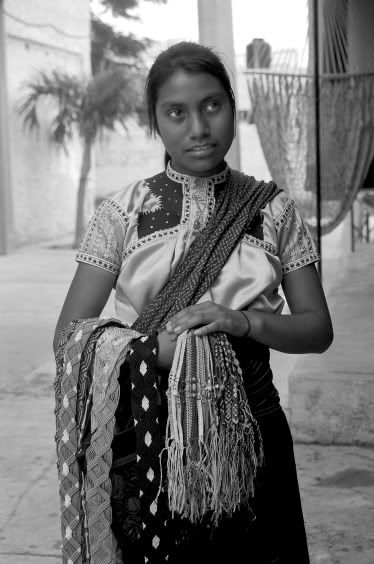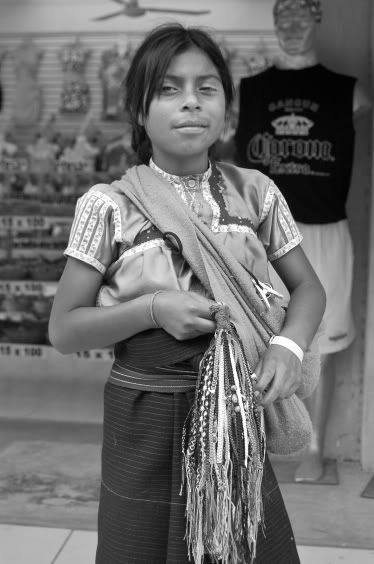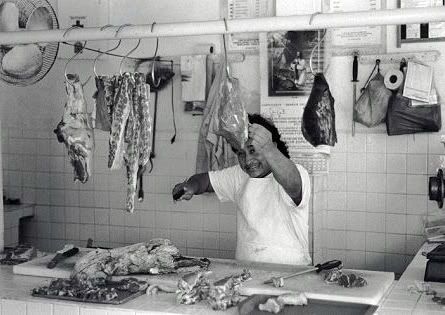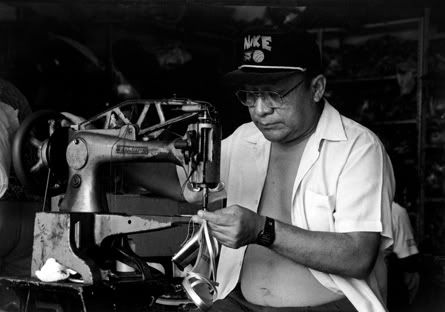Sunday, April 27, 2008
Tuesday, April 22, 2008
Mark it Down!
"Scott's Lawn Held Hostage, Day 149, Hello, I'm Ted Koppell....."
In honor of my grass being freed from the grip of it's icy shackles, I'd like to share a few images that always warm me up.




 I'm really going to enjoy this summer. It's been a long time coming.
I'm really going to enjoy this summer. It's been a long time coming.
Posted by
Scott Bulger Photography
at
10:35 AM
10
Interesting Thoughts
![]()
Labels: Sunrise Sunset
Wednesday, April 16, 2008
When does a photograph stop being a photograph?
When does an image stop being a photograph and start becoming something else?
This is a discussion that has been going on for some time and will never have an answer that everyone agrees on.
Please understand, that my point of view is colored by being someone that I consider to be shooting "straight" photographs.
The key to me is "Representation". How are you representing your image? As long as it is being represented accurately, then no one should have a problem with however you choose to express yourself. Someone superimposing an image of a gigantic moon behind the silhouette of a sailboat and claiming it is an "authentic" photograph, even though it would have been physically impossible to create the image with a single exposure is being misleading.
Now it gets even stickier. Where does "manipulation" begin that would force you to represent your image as something other than "straight" photography? To me, it is the introduction of elements that were not in the original, or, other manipulation that is obviously something that would not be seen by a person with normal eyesight. Any processes that could easily be done in a darkroom (dodging, burning, saturation/desaturation, etc...) that simply enhances an image will still allow me to call my work straight photography. If I go to a balloon rally and take 8 photographs of 8 different balloons, then come home and use my computer to put them all into a single frame, I can not represent that as a photograph without a clear explanation as to what was done to alter it from the original state. It can still certainly be art, and some will probably still call it a photograph, but I couldn't represent it as such. I could call it a "photo-montage" or a "photo-mosaic" or something similar. I couldn't represent it as such even if I had done the work in a traditional darkroom by using multiple exposures or overlaying negatives.
Part of this reasoning is what I feel is my responsibility to any aspiring or beginning photographers that might see an image and be inspired to reproduce it without knowing how heavily manipulated it really was. They would go out time after time, attempting to recreate an image and would be unable to do so, possibly becoming discouraged and stop trying. Everyone wants to be able to create something they consider beautiful. They should be given all the information to do so.
Maybe something that is created as art shouldn't have to be explained...maybe it should just be able to stand on it's own and be admired without it being labeled or categorized...maybe something beautiful to look at should be just that....
Posted by
Scott Bulger Photography
at
7:57 AM
9
Interesting Thoughts
![]()
Labels: photography philosophy
Wednesday, April 9, 2008
Odds and Ends
I've been pretty busy, so I haven't had a chance to blog for a few days. I haven't had time to put together a coherent article for today either, so I'm just going to drop a few nuggets in here.
 My photograph, "Bullfight", is being used as set dressing for the upcoming movie "The Assassination of a High School President" starring Bruce Willis. This film is being released in September and the according to the art director on the project, my photograph is being used in a Spanish classroom.
My photograph, "Bullfight", is being used as set dressing for the upcoming movie "The Assassination of a High School President" starring Bruce Willis. This film is being released in September and the according to the art director on the project, my photograph is being used in a Spanish classroom. Another photograph of mine, "Wood End Light #4", is being used in the film "Tell-Tale", starring Josh Lucas and Lena Headley. This film will be released sometime in 2009 as they are just wrapping up filming now.
Another photograph of mine, "Wood End Light #4", is being used in the film "Tell-Tale", starring Josh Lucas and Lena Headley. This film will be released sometime in 2009 as they are just wrapping up filming now.Ansel Adams once said "Twelve significant photographs in any one year, is a good crop." Don't think that every shot you snap is a keeper. Family and friends are one thing, but if you are trying to create "art"....well, most photographers need to be much better editors of their own work. The last three times I've shot, I haven't printed a single image.
Do you want to know if your work is any good? Do you really want to know? Don't ask your mother, your best friend, or any other relative. Ask someone whose work you respect. Not whose work you like, someone whose work you respect. there is a difference. You want to be able to respect their opinion, not like it. Be prepared for the truth, and sometimes, the truth isn't pretty, but the truth will make you a better photographer.
Crooked horizons are a result of laziness. They are easy to check and to fix. Check them and fix them.
Blown out highlights kill an image. Just kill it. Portraits, landscapes, still life, it doesn't matter.
Posted by
Scott Bulger Photography
at
7:49 AM
17
Interesting Thoughts
![]()
Labels: Editing, Highlights, Horizons, Movies
Friday, April 4, 2008
Vacation Photography
The key to good travel photography is to bring the viewer with you on your journey. You need to make them feel like they are remembering their own trip, as opposed to just looking at a photographic record of yours. To do this, you need to make a record of the places you visited and the people you met. In order to do this, you need to actually go places and meet people. Get off of the beach and out of the hotel. Your family and friends already know what you look like, they may not know what a butcher shop in Mexico look like.
Don't miss out on the local cuisine, architecture, and flora by staying quarantined to your resort or hotel. By experiencing the actual culture of the country that you are visiting, it's easier to capture the essence of the culture in photographs.
Take pictures of the sunset and the pool and the beach, but don't forget to take pictures of where you actually are.






Posted by
Scott Bulger Photography
at
9:57 AM
18
Interesting Thoughts
![]()
Labels: Mexico portraits vacation
Wednesday, April 2, 2008
Time to Build a Portfolio
Do you want to get serious about your photography? Fancy yourself a professional? Let's talk about putting together a portfolio. If you want to show your work, if you want to get more business, if you are looking to start a business, If you are looking for representation or trying to get shown in a gallery, nothing will have more impact than your portfolio.
Here are a few things to take into consideration when putting together your book:
Your portfolio should consist of between 15 and 30 images. Less than 15 doesn't show enough depth and experience, and more than 30 becomes cumbersome and tedious to look through.
Especially for novices and upstarts, the portfolio is often their weakest link. This is usually due to the fact that they are drawing from too little work. Be your own harshest critic. Look at the images you are considering closely. Try to find reasons to keep them out of your book. If you can't find a flaw, put them in. "This is good enough" is NOT good enough. Only your absolute very best images go into your book. I cannot stress this enough. You have never met a more critical person than a photo editor, so no matter how tough you think you are being on your work, it isn't tough enough.
Don't make excuses for your work. If it's not right, it's not right. Leave it out. If you specialize in wildlife photography, and you have an image that is great in every way except that the subjects eyes are obscured or out of focus, do not include it. If the viewer notices and says something like "too bad about the eyes", what do you do then? Make excuses? That isn't going to fly.
Make sure that your work speaks for itself and doesn't require an explanation. It's quite possible that you won't be there when your book is viewed.
Your portfolio needs to have a consistent theme. Don't mix landscapes with portraits. Don't mix still life with architecture. Don't mix color with black and white. Specialize at least in your books. If you want to promote different styles of photography, have different books. Make sure all of your images are the same proportions. Do your cropping with your camera so you aren't cropping after the fact and changing the proportions of your image. If you have to crop after you have already taken the shot, keep the proportions consistent. Don't have a book of 13 x 19's and then have an 8x10 and a 12 x 12. One book, one size.
Personally, I have some nice leather looking books with high quality plastic inlays, but these can sometimes be problematic if the lighting isn't right. A glare from the plastic can be a real momentum killer. There are many different display modes; figure out what will be the right one for you. Don't be afraid to be imaginative or creative. For the time being at least, electronic methods still don't make the grade. Decision makers still want hard copies so that they are easy to pass around and really see what they are looking at. 72 DPI electronically displayed images don't hold a candle to an actually printed image.
Posted by
Scott Bulger Photography
at
7:51 AM
9
Interesting Thoughts
![]()
Labels: display, gallery, portfolio, representaton




